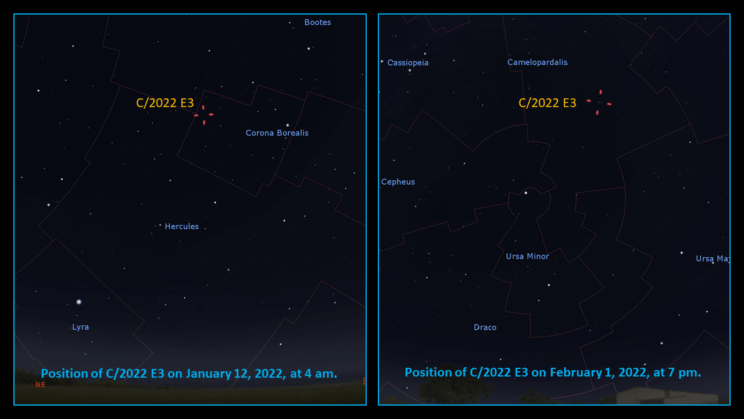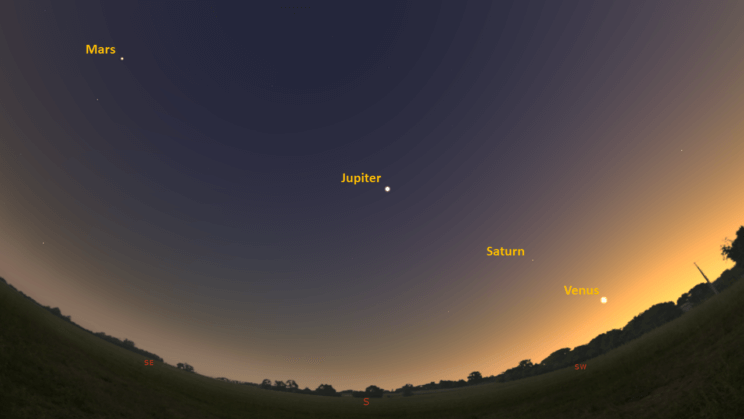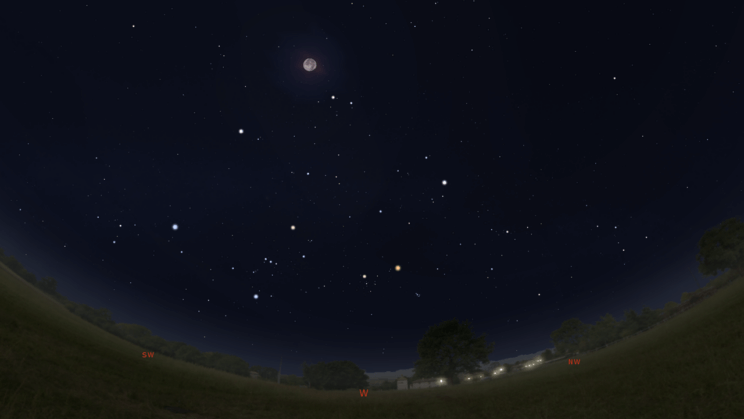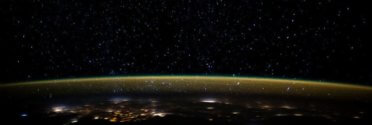This is the Saint Louis Science Center’s NIGHT SKY UPDATE for the week of Friday, January 6, 2023.
Information updated weekly or as needed.
Times given as local St. Louis time which is Central Standard Time (CST). For definitions of terminology used in the night sky update, click the highlighted text. If relying on times posted in Universal Time (UT), St. louis is -6 hours when CST.
Public Telescope Viewings
As part of the Saint Louis Science Center’s First Fridays, weather permitting, the St. Louis Astronomical Society and the Science Center will set up a number of telescopes outdoors and be on-hand to answer your questions. Telescope viewing begins once it is dark. Regardless of the weather on February 3, join us indoors in our planetarium theater for “The Sky Tonight”. Showtime is at 7 p.m.
Observing Highlight of the Week

Position of comet C/2022 E3 (ZTF) on the dates of perihelion and closest approach to Earth. Image created using Stellarium.
On January 12, 2023, comet C/2022 E3 (ZTF) will make its closest approach to the Sun. At the time of perihelion, the comet will be roughly 1.1 AU from the Sun. A few weeks later, the comet passes nearest to Earth on February 1, 2023, at a distance of 26.4 million miles. Models predict that C/2022 E3 (ZTF) could become bright enough to see naked eye. Anyone that has tracked comets before knows all too well that comet predictions are just predictions. Comets often fail to reach magnitudes the models predict. They can also behave in ways that exceed predictions. So anytime there is a possibility of a bright comet, it is worth keeping track of.
C/2022 E3 (ZTF) was discovered by the Zwicky Transit Facility (ZTF) at the Palomar Observatory on March 2, 2022. ZTF is an extremely wide-field camera that scans the entire northern sky on a 2-day interval looking for a variety of things such as active galactic nuclei and small solar system bodies. Comets are typically named after what discovers them. These days most comets are found by surveys such as ZTF, NEOWISE and Pan-STARRS. However, there are still occasions when amateur astronomers discover new comets. One of the most prolific comet hunters is an Australian amateur astronomer named Terry Lovejoy. He has discovered six comets with the most recent being C/2017 E4 (Lovejoy). Reaching 7th magnitude, this comet is a great example of one that exceeded predictions. It briefly became a 7th magnitude object and was visible through binocular.
If we are lucky, and C/2022 E3 (ZTF) increases to 5th magnitude, we should be able to spot it naked eye in the early evening at the start of February. Right now, the comet is moving out of the constellation Corona Borealis with magnitude estimates hovering around 7.5. C/2022 E3 (ZTF) is behaving as the models predicted so we should have a nice comet to track down in just shy of a month. Currently, telescopes are necessary to spot the comet but that should change soon as the comet moves into northern skies.
In January, C/2022 E3 (ZTF) will pass through several constellations as it becomes a circumpolar target. Once the comet moves out of Corona Borealis on January 14, 2023, it will pass through the constellations Boötes, Draco, Ursa Minor and eventually Camelopardalis as it approaches its nearest point to Earth. C/2022 E3 (ZTF) will be visible all night as we enter the last week of January, and it should be brightest by February 1, 2023. It is possible the comet could experience outburst periods which could cause the comet to be brighter than expected. Our best views will likely occur over the last week of January and the first two weeks of February. The Moon will impact what we see after January 28, 2023 as it shifts into its gibbous phases. Unfortunately, when C/2022 E3 (ZTF) is closest to Earth, the Moon will have roughly 86% disk illumination. It is possible that even if C/2022 E3 (ZTF) reaches naked eye visibility, due to the Moon, we may need to use binoculars to spot it.
If you would like to track this comet, there are several resources online that will help. The two I highly recommend are Comet Chasing and COBS. Additionally, if you would like to see images of C/2022 E3 (ZTF), Spaceweather.com has a comet image gallery that is updated as new images are posted.
The Sun and Moon

The Moon as seen from the International Space Station, on July 31, 2011.
Credit: NASA
Sunrise is at 7:19 a.m. on Friday, January 6 and sunset is at 4:54 p.m. providing us with roughly 9.5 hours of daylight. Even after sunset, light from the Sun will dimly illuminate our sky for roughly 1 hour and 30 minutes. This period is called twilight, which ends around 6:30 p.m. this week. For those with a sundial, local noon occurs around 12:06 p.m. this week.
| Day | Sunrise | Sunset |
|---|---|---|
| 2023-01-06 | 7:19 a.m. | 4:54 p.m. |
| 2023-01-07 | 7:19 a.m. | 4:55 p.m. |
| 2023-01-08 | 7:19 a.m. | 4:56 p.m. |
| 2023-01-09 | 7:19 a.m. | 4:57 p.m. |
| 2023-01-10 | 7:18 a.m. | 4:58 p.m. |
| 2023-01-11 | 7:18 a.m. | 4:59 p.m. |
| 2023-01-12 | 7:18 a.m. | 5:00 p.m. |
| 2023-01-13 | 7:18 a.m. | 5:01 p.m. |
| 2023-01-14 | 7:17 a.m. | 5:02 p.m. |
Moon
Moonrise for Friday, January 6 is at 4:32 p.m. and moonset occurs at 8:12 a.m. on the following day. Friday, January 6, the Moon will exhibit a full phase with 100% of the lunar disk illuminated. Full moon occurs on January 6, 2023, at 5:08 p.m. This is the first of 13 full moons in 2023.
International Space Station (ISS) Observing

There are several visible passes of ISS from St. Louis for the week of January 6. They occur during morning and evening hours. The best passes for this week are listed below. Use the table below for information about these passes.
Catch ISS from St. Louis starting Friday, January 6
| Date | Starts | Max. altitude | Ends | |||||||
|---|---|---|---|---|---|---|---|---|---|---|
| Time | Alt. | Az. | Time | Alt. | Az. | Time | Alt. | Az. | ||
| 07 Jan | -2.1 | 05:08:19 | 34 | ESE | 05:08:19 | 34 | ESE | 05:10:21 | 10 | ESE |
| 08 Jan | -2.1 | 05:55:12 | 20 | SW | 05:55:12 | 20 | SW | 05:57:37 | 10 | S |
| 14 Jan | -1.4 | 19:19:06 | 10 | SW | 19:20:19 | 21 | SW | 19:20:19 | 21 | SW |
Magnitude (Mag): The Measure of brightness for a celestial object. The lower the value is, the brighter the object will be.
Altitude (Alt): The angle of a celestial object measured upwards from the observer’s horizon.
Azimuth (Az): The direction of a celestial object, measured clockwise from an observer’s location with north being 0°, east being 90°, south being 180° and west being 270°.
For information about ISS flyovers and other visible satellites, visit www.heavens-above.com
Detailed information regarding all unmanned exploration of our universe, missions past, present, and planned, can be found at Jet Propulsion Laboratories:
The Visible Planets

Looking south at 5:20 p.m. on January 7, 2023. Credit: Stellarium, EG

Looking west at 2:00 a.m. on January 8, 2023. Credit: Stellarium, EG.
This week, four naked eye planets are visible. Mars rises in the early evening and is visible most of the night. Jupiter and Saturn rise before sunset and will be visible once it is dark. Venus is visible in the west about 20 minutes after sunset.
Venus
Venus is climbing out of the Sun’s glare as it starts another an evening apparition. Once high enough above the horizon, Venus will be a bright target in the west after sunset until August 2023 when it approaches inferior conjunction.
Mars
Mars now rises before sunset becoming visible once it is dark. Look for it in the east about 30 minutes after sunset.
Jupiter
Now past opposition, Jupiter will be visible about 30 minutes after sunset. Jupiter reaches superior conjunction on April 11, 2023. As we progress towards this date, we will see Jupiter slowly wander towards the Sun.
Saturn
Now past opposition, Saturn rises before the Sun sets. You can find this giant world in the south about 45 minutes after sunset. Saturn is still a fine target though telescopes and will be a highlight of the evening sky for the rest of the year.
James S. McDonnell Planetarium
Night Sky Update: January 6 – 14, 2023







